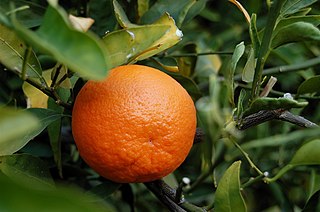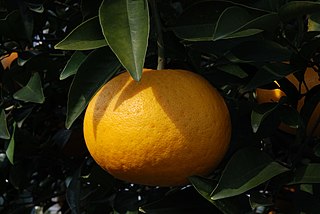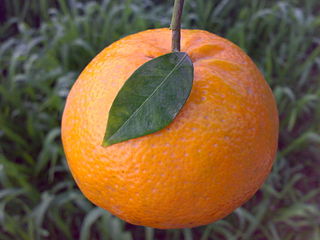
Kumquats, or cumquats in Australian English, are a group of small, angiosperm, fruit-bearing trees in the family Rutaceae. Their taxonomy is disputed. They were previously classified as forming the now-historical genus Fortunella or placed within Citrus, sensu lato. Different classifications have alternatively assigned them to anywhere from a single species, C. japonica, to numerous species representing each cultivar. Recent genomic analysis defines three pure species, Citrus hindsii, C. margarita and C. crassifolia, with C. x japonica being a hybrid of the last two.

Citrus is a genus of flowering trees and shrubs in the rue family, Rutaceae. Plants in the genus produce citrus fruits, including important crops such as oranges, lemons, grapefruits, pomelos, and limes. The genus Citrus is native to South Asia, East Asia, Southeast Asia, Melanesia, and Australia. Various citrus species have been used and domesticated by indigenous cultures in these areas since ancient times. From there its cultivation spread into Micronesia and Polynesia by the Austronesian expansion ; and to the Middle East and the Mediterranean via the incense trade route, and onwards to Europe and the Americas.

The mandarin orange, also known as mandarin or mandarine, is a small, rounded citrus tree fruit. Treated as a distinct species of orange, it is usually eaten plain or in fruit salads. Tangerines are a group of orange-coloured citrus fruit consisting of hybrids of mandarin orange with some pomelo contribution.

The tangerine is a type of citrus fruit that is orange in color, that is considered either a variety of Citrus reticulata, the mandarin orange, or a closely related species, under the name Citrus tangerina, or yet as a hybrid of mandarin orange varieties, with some pomelo contribution.

The tangelo, Citrus × tangelo, is a citrus fruit hybrid of a Citrus reticulata variety, such as mandarin orange or tangerine, and a Citrus maxima variety, such as a pomelo or grapefruit. The name is a portmanteau of 'tangerine' and 'pomelo'.

Citrus unshiu is a semi-seedless and easy-peeling citrus species, also known as miyagawa mandarin,unshu mikan, cold hardy mandarin, satsuma mandarin, satsuma orange, naartjie, and tangerine. During the Edo period of Japan, kishu mikan was the most popular because there was a popular superstition that eating Citrus unshiu (Satsuma) without seeds made people more prone to infertility. Citrus unshiu became popular in Japan after modernization started in the Meiji period. It was introduced to the West from the Satsuma region of Japan in 1878.

Amanatsu or kawano natsu daidai is a yellow citrus fruit, a cultivar that originated as a mutation of the natsu mikan or natsu daidai. It was discovered in 1935 in Tsukumi, Oita Prefecture, Japan. The original natsu mikan that served as the basis for amanatsu was found in Yamaguchi Prefecture around 1700.

Dekopon (デコポン) is a seedless and sweet variety of satsuma orange.

An orange is a fruit of various citrus species in the family Rutaceae ; it primarily refers to Citrus × sinensis, which is also called sweet orange, to distinguish it from the related Citrus × aurantium, referred to as bitter orange. The sweet orange reproduces asexually ; varieties of the sweet orange arise through mutations.

The Kinnow is a high yield mandarin hybrid cultivated extensively in the wider Punjab region of India and Pakistan.

The Kojiki and Nihon Shoki, compiled in the 700s, were the first books in Japan to describe citrus fruits. The Nihon Shoki states that a man named Tajimamori brought back citrus fruits from the Tokoyo no kuni on the orders of Emperor Suinin, which is thought to refer to the tachibana orange that grows wild in Japan. The Man'yōshū, a collection of poems from the same period, contains many poems about tachibana orange, and because of its strong acidity at the time, it was dried and used for medicinal and ornamental purposes rather than for food. The Kokin Wakashū, compiled in the 900s, mentions that tachibana orange was burned and used as incense to give a nice fragrance to kimonos. In Japan, tachibana orange is a symbol of eternity and is the motif for the Order of Culture.

Kiyomi is a Japanese citrus fruit that is a hybrid of a Miyagawa Wase mikan and an orange. The new breed was the first tangor created in Japan in 1949. It was named Kiyomi after the temple Seiken-ji (清見寺) and the lagoon Kiyomi-gata (清見潟) near its experiment station in Shizuoka city and registered as "Tangor Nōrin No.1" in 1979.

The lemon is a species of small evergreen tree in the flowering plant family Rutaceae, native to Asia, primarily Northeast India (Assam), Northern Myanmar, or China.

Reikou is a cultivar of tangor. It is a citrus hybrid of a hybrid of Kiyomi and Encore and Murcott tangor.

Shonan Gold (湘南ゴールド) is a hybrid Japanese citrus, with a characteristic "golden" bright yellow color.

Ōgonkan or Ki-mikan are the common names for a small sized variety of Japanese citrus, whose rind is of a characteristic "golden" bright yellow color.

Hassaku orange is Japanese citrus hybrid similar to an orange in color but with the size of a grapefruit.
'Encore' mandarin is a citrus cultivar.
Kuchinotsu No. 37 is a tangor cultivar grown in Japan.

Haruka is a Citrus cultivar grown in Japan and the Korean Peninsula.



















